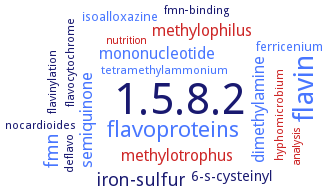1.5.8.2: trimethylamine dehydrogenase
This is an abbreviated version!
For detailed information about trimethylamine dehydrogenase, go to the full flat file.

Word Map on EC 1.5.8.2 
-
1.5.8.2
-
flavin
-
flavoproteins
-
fmn
-
iron-sulfur
-
semiquinone
-
mononucleotide
-
methylotrophus
-
methylophilus
-
dimethylamine
-
6-s-cysteinyl
-
isoalloxazine
-
ferricenium
-
flavocytochrome
-
nocardioides
-
flavinylation
-
fmn-binding
-
tetramethylammonium
-
deflavo
-
hyphomicrobium
-
analysis
-
nutrition
- 1.5.8.2
- flavin
- flavoproteins
- fmn
-
iron-sulfur
- semiquinone
- mononucleotide
- methylotrophus
- methylophilus
- dimethylamine
-
6-s-cysteinyl
- isoalloxazine
- ferricenium
-
flavocytochrome
-
nocardioides
-
flavinylation
-
fmn-binding
- tetramethylammonium
-
deflavo
- hyphomicrobium
- analysis
- nutrition
Reaction
Synonyms
EC 1.5.99.7, More, TMA dehydrogenase, TMADH, TMD, TMDH
ECTree
Advanced search results
Inhibitors
Inhibitors on EC 1.5.8.2 - trimethylamine dehydrogenase
Please wait a moment until all data is loaded. This message will disappear when all data is loaded.
1-phenylcyclopropylamine
-
irreversible inactivation of both wild-type and mutant C30A
1-phenylethylhydrazine
methylotrophic bacterium
-
potent inhibition at very low concentration
2-phenylethylhydrazine
methylotrophic bacterium
-
potent inhibition at very low concentration
acetaldehyde
-
noncompetitive inhibition with respect to diethylamine, uncompetitive inhibition with respect to phenazine methosulfate
Diethylamine
-
noncompetitive product inhibition with respect to phenazine methosulfate
diphosphate
-
noncompetitive inhibition to 50% of initial activity with respect to trimethylamine
ethylamine
-
noncompetitive product inhibition with respect to phenazine methosulfate
ferricinium
-
Val334 is involved in binding and initiates a conformational change interrupting the electron transfer between FMN and the [4Fe-4S] cluster
hexamethylene bis-trimethylammonium chloride
methylotrophic bacterium
-
potent inhibition at 1 mM
N,N,N-trimethyl-N-phenylammonium chloride
methylotrophic bacterium
-
potent inhibition at 1 mM
N-cyclopropyl-alpha-methylbenzylamine
-
irreversible inactivation of both wild-type and mutant C30A, more potent than 1-phenylcyclopropylamine
additional information
-
no inhibition by (dimethylamino)methylene ferrocene, ferrocenedicarboxylic acid, ferrocenemonocarboxylic acid, ferrocenedimathanol, (dimethylamino)methylene ferrocene, ferricyanide, and thionine
-
-
irreversible inactivation of both wild-type and mutant C30A, 10 times more potent than N-cyclopropyl-alpha-methylbenzylamine
phenylhydrazine
-
lowers the requirement of reducing equivalents from three to 0.9
phenylhydrazine
-
progressive loss of activity by reaction with FMN, trimethylamine or tetramethylammonium chloride protect against inactivation


 results (
results ( results (
results ( top
top






